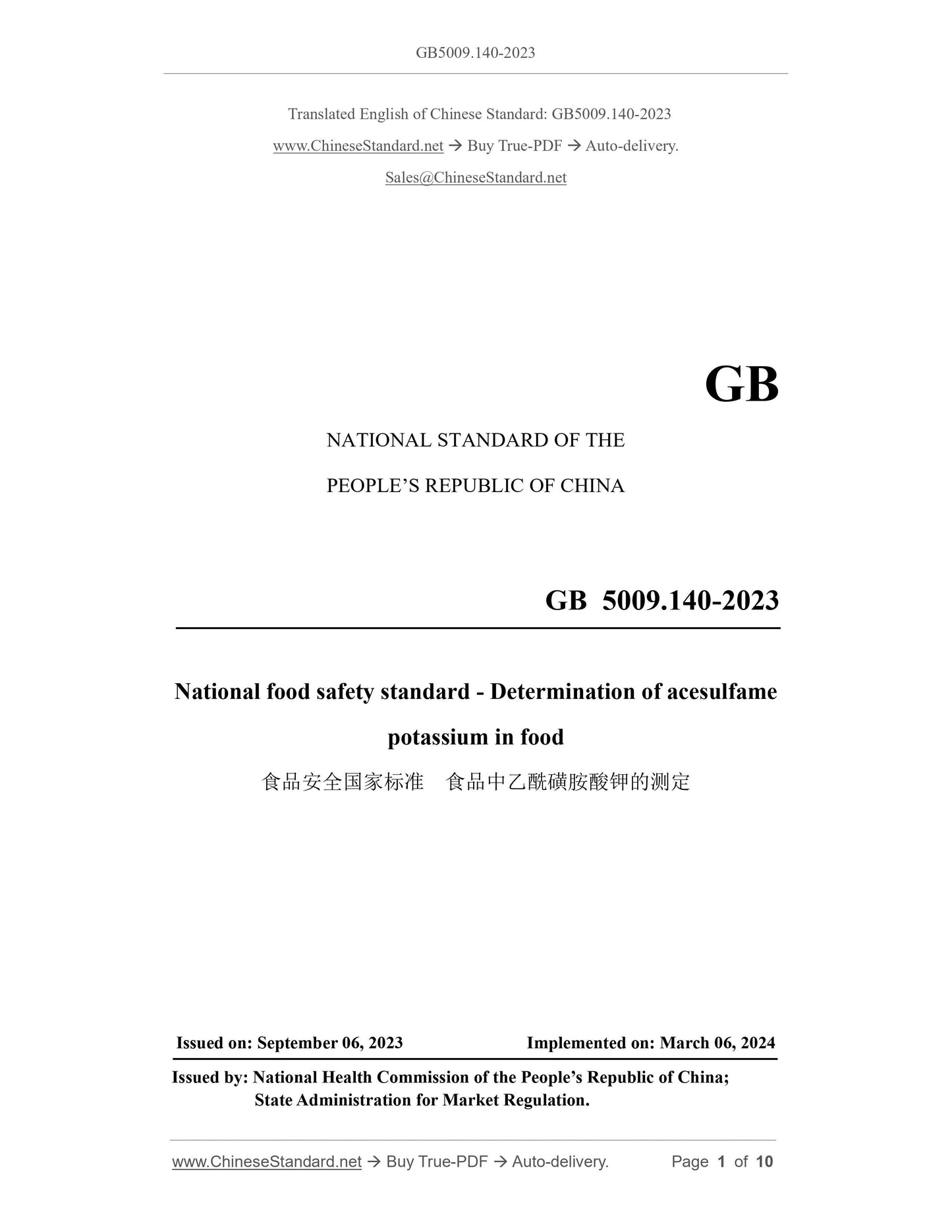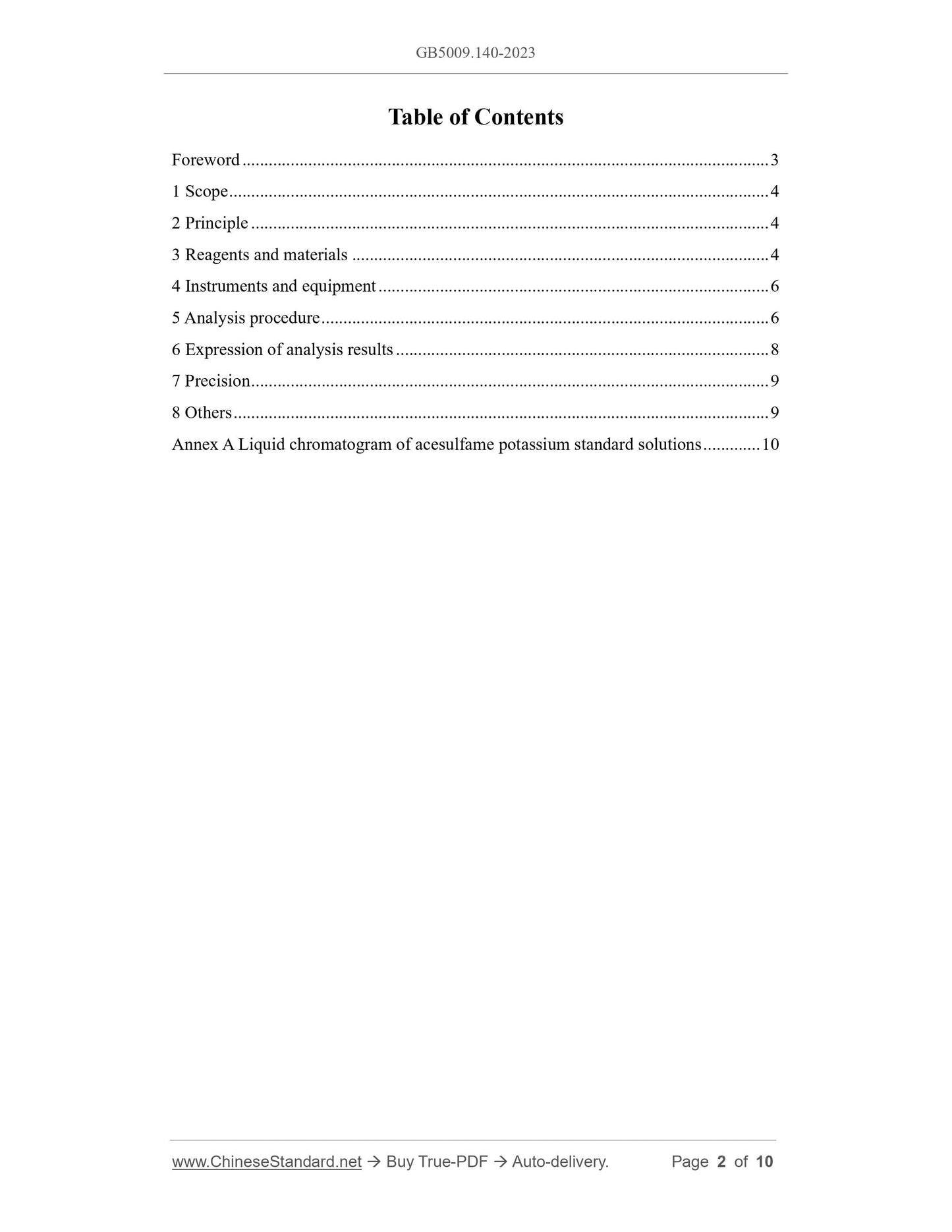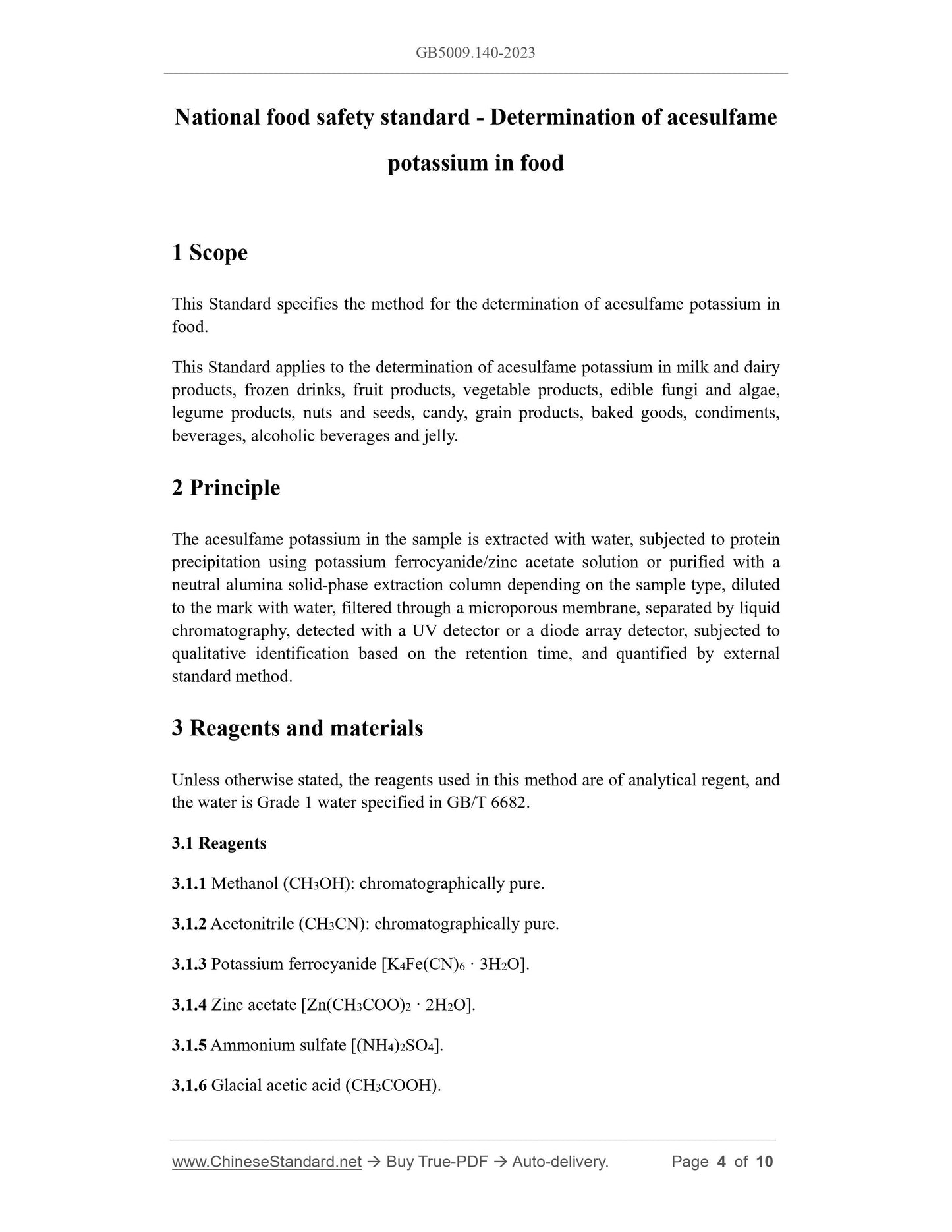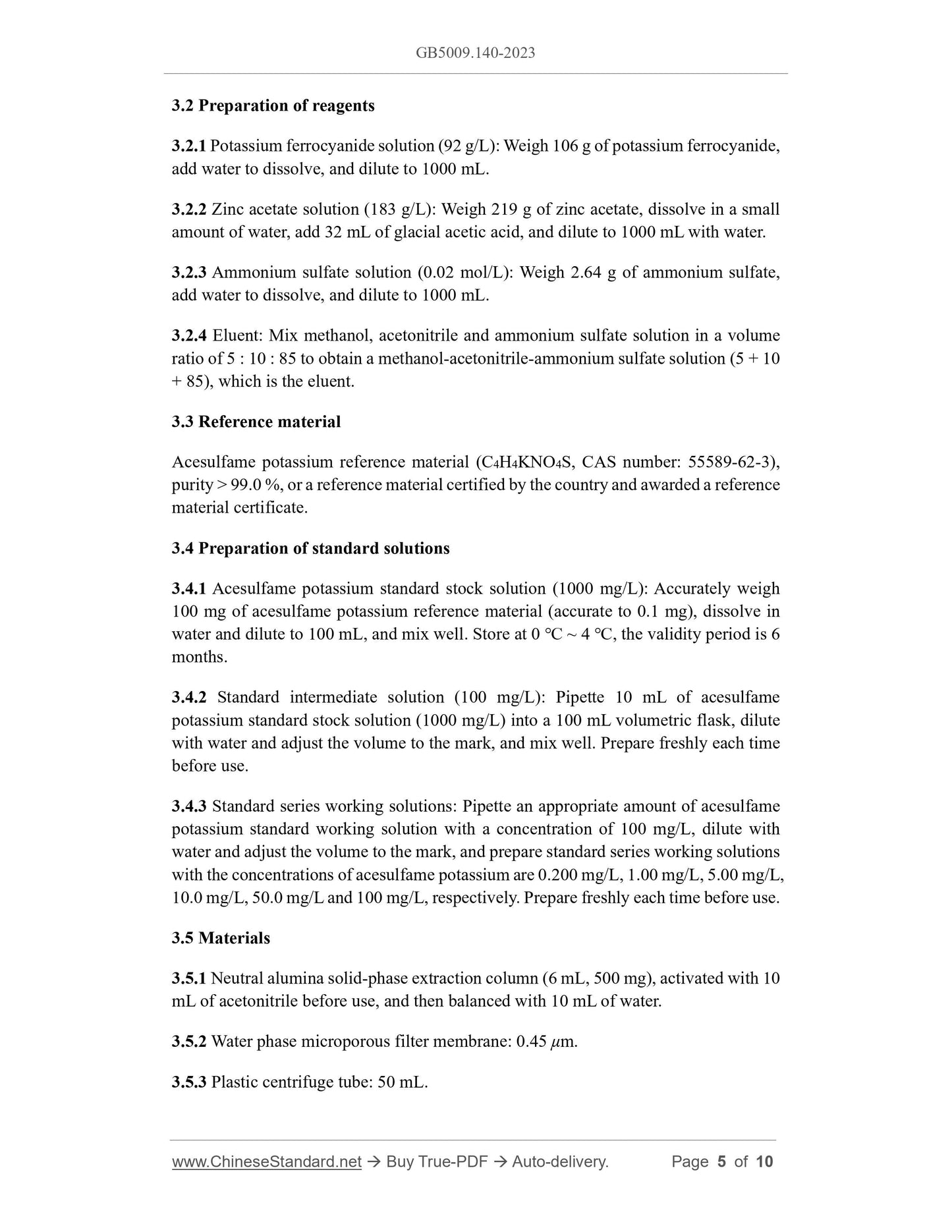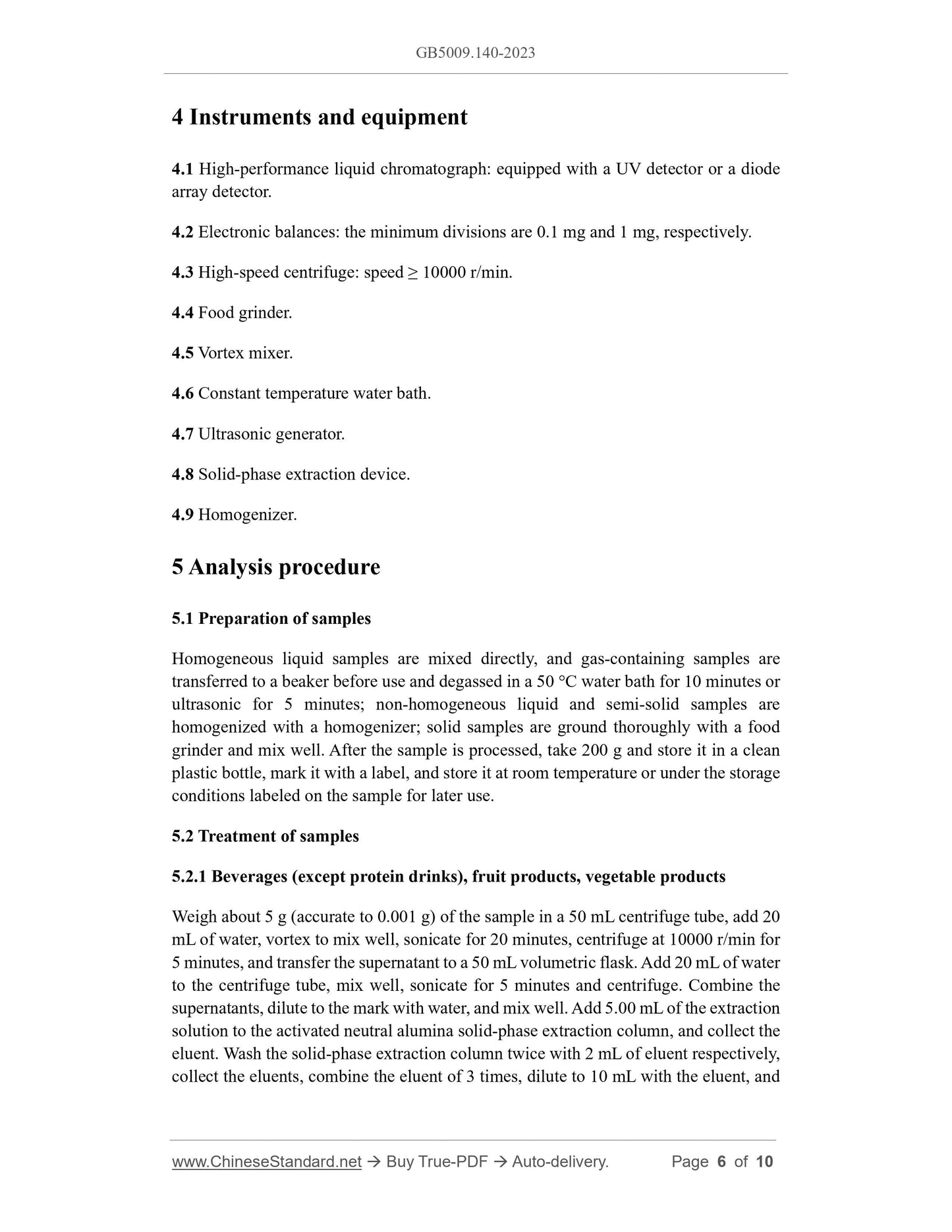1
/
su
5
PayPal, credit cards. Download editable-PDF and invoice in 1 second!
GB 5009.140-2023 English PDF (GB5009.140-2023)
GB 5009.140-2023 English PDF (GB5009.140-2023)
Prezzo di listino
$140.00 USD
Prezzo di listino
Prezzo scontato
$140.00 USD
Prezzo unitario
/
per
Spese di spedizione calcolate al check-out.
Impossibile caricare la disponibilità di ritiro
Delivery: 3 seconds. Download true-PDF + Invoice.
Get QUOTATION in 1-minute: Click GB 5009.140-2023
Historical versions: GB 5009.140-2023
Preview True-PDF (Reload/Scroll if blank)
GB 5009.140-2023: National food safety standard - Determination of acesulfame K in food
GB 5009.140-2023
GB
NATIONAL STANDARD OF THE
PEOPLE’S REPUBLIC OF CHINA
GB 5009.140-2023
National food safety standard - Determination of acesulfame
potassium in food
ISSUED ON: SEPTEMBER 06, 2023
IMPLEMENTED ON: MARCH 06, 2024
Issued by: National Health Commission of the People’s Republic of China;
State Administration for Market Regulation.
Table of Contents
Foreword ... 3
1 Scope ... 4
2 Principle ... 4
3 Reagents and materials ... 4
4 Instruments and equipment ... 6
5 Analysis procedure ... 6
6 Expression of analysis results ... 8
7 Precision ... 9
8 Others ... 9
Annex A Liquid chromatogram of acesulfame potassium standard solutions ... 10
National food safety standard - Determination of acesulfame
potassium in food
1 Scope
This Standard specifies the method for the determination of acesulfame potassium in
food.
This Standard applies to the determination of acesulfame potassium in milk and dairy
products, frozen drinks, fruit products, vegetable products, edible fungi and algae,
legume products, nuts and seeds, candy, grain products, baked goods, condiments,
beverages, alcoholic beverages and jelly.
2 Principle
The acesulfame potassium in the sample is extracted with water, subjected to protein
precipitation using potassium ferrocyanide/zinc acetate solution or purified with a
neutral alumina solid-phase extraction column depending on the sample type, diluted
to the mark with water, filtered through a microporous membrane, separated by liquid
chromatography, detected with a UV detector or a diode array detector, subjected to
qualitative identification based on the retention time, and quantified by external
standard method.
3 Reagents and materials
Unless otherwise stated, the reagents used in this method are of analytical regent, and
the water is Grade 1 water specified in GB/T 6682.
3.1 Reagents
3.1.1 Methanol (CH3OH): chromatographically pure.
3.1.2 Acetonitrile (CH3CN): chromatographically pure.
3.1.3 Potassium ferrocyanide [K4Fe(CN)6 · 3H2O].
3.1.4 Zinc acetate [Zn(CH3COO)2 · 2H2O].
3.1.5 Ammonium sulfate [(NH4)2SO4].
3.1.6 Glacial acetic acid (CH3COOH).
3.2 Preparation of reagents
3.2.1 Potassium ferrocyanide solution (92 g/L): Weigh 106 g of potassium ferrocyanide,
add water to dissolve, and dilute to 1000 mL.
3.2.2 Zinc acetate solution (183 g/L): Weigh 219 g of zinc acetate, dissolve in a small
amount of water, add 32 mL of glacial acetic acid, and dilute to 1000 mL with water.
3.2.3 Ammonium sulfate solution (0.02 mol/L): Weigh 2.64 g of ammonium sulfate,
add water to dissolve, and dilute to 1000 mL.
3.2.4 Eluent: Mix methanol, acetonitrile and ammonium sulfate solution in a volume
ratio of 5 : 10 : 85 to obtain a methanol-acetonitrile-ammonium sulfate solution (5 + 10
+ 85), which is the eluent.
3.3 Reference material
Acesulfame potassium reference material (C4H4KNO4S, CAS number: 55589-62-3),
purity > 99.0 %, or a reference material certified by the country and awarded a reference
material certificate.
3.4 Preparation of standard solutions
3.4.1 Acesulfame potassium standard stock solution (1000 mg/L): Accurately weigh
100 mg of acesulfame potassium reference material (accurate to 0.1 mg), dissolve in
water and dilute to 100 mL, and mix well. Store at 0 ℃ ~ 4 ℃, the validity period is 6
months.
3.4.2 Standard intermediate solution (100 mg/L): Pipette 10 mL of acesulfame
potassium standard stock solution (1000 mg/L) into a 100 mL volumetric flask, dilute
with water and adjust the volume to the mark, and mix well. Prepare freshly each time
before use.
3.4.3 Standard series working solutions: Pipette an appropriate amount of acesulfame
potassium standard working solution with a concentration of 100 mg/L, dilute with
water and adjust the volume to the mark, and prepare standard series working solutions
with the concentrations of acesulfame potassium are 0.200 mg/L, 1.00 mg/L, 5.00 mg/L,
10.0 mg/L, 50.0 mg/L and 100 mg/L, respectively. Prepare freshly each time before use.
3.5 Materials
3.5.1 Neutral alumina solid-phase extraction column (6 mL, 500 mg), activated with 10
mL of acetonitrile before use, and then balanced with 10 mL of water.
3.5.2 Water phase microporous filter membrane: 0.45 μm.
3.5.3 Plastic centrifuge tube: 50 mL.
4 Instruments and equipment
4.1 High-performance liquid chromatograph: equipped with a UV detector or a diode
array detector.
4.2 Electronic balances: the minimum divisions are 0.1 mg and 1 mg, respectively.
4.3 High-speed centrifuge: speed ≥ 10000 r/min.
4.4 Food grinder.
4.5 Vortex mixer.
4.6 Constant temperature water bath.
4.7 Ultrasonic generator.
4.8 Solid-phase extraction device.
4.9 Homogenizer.
5 Analysis procedure
5.1 Preparation of samples
Homogeneous liquid samples are mixed directly, and gas-containing samples are
transferred to a beaker before use and degassed in a 50 °C water bath for 10 minutes or
ultrasonic for 5 minutes; non-homogeneous liquid and semi-solid samples are
homogenized with a homogenizer; solid samples are ground thoroughly with a food
grinder and mix well. After the sample is processed, take 200 g and store it in a clean
plastic bottle, mark it with a label, and store it at room temperature or under the storage
conditions labeled on the sample for later use.
5.2 Treatment of samples
5.2.1 Beverages (except protein drinks), fruit products, vegetable products
Weigh about 5 g (accurate to 0.001 g) of the sample in a 50 mL centrifuge tube, add 20
mL of water, vortex to mix well, sonicate for 20 minutes, centrifuge at 10000 r/min for
5 minutes, and transfer the supernatant to a 50 mL volumetric flask. Add 20 mL of water
to the centrifuge tube, mix well, sonicate for 5 minutes and centrifuge. Combine the
supernatants, dilute to the mark with water, and mix well. Add 5.00 mL of the extraction
solution to the activated neutral alumina solid-phase extraction column, and collect the
eluent. Wash the solid-phase extraction column twice with 2 mL of eluent respectively,
collect the eluents, combine the eluent of 3 times, dilute to 10 mL with the eluent, and
Get QUOTATION in 1-minute: Click GB 5009.140-2023
Historical versions: GB 5009.140-2023
Preview True-PDF (Reload/Scroll if blank)
GB 5009.140-2023: National food safety standard - Determination of acesulfame K in food
GB 5009.140-2023
GB
NATIONAL STANDARD OF THE
PEOPLE’S REPUBLIC OF CHINA
GB 5009.140-2023
National food safety standard - Determination of acesulfame
potassium in food
ISSUED ON: SEPTEMBER 06, 2023
IMPLEMENTED ON: MARCH 06, 2024
Issued by: National Health Commission of the People’s Republic of China;
State Administration for Market Regulation.
Table of Contents
Foreword ... 3
1 Scope ... 4
2 Principle ... 4
3 Reagents and materials ... 4
4 Instruments and equipment ... 6
5 Analysis procedure ... 6
6 Expression of analysis results ... 8
7 Precision ... 9
8 Others ... 9
Annex A Liquid chromatogram of acesulfame potassium standard solutions ... 10
National food safety standard - Determination of acesulfame
potassium in food
1 Scope
This Standard specifies the method for the determination of acesulfame potassium in
food.
This Standard applies to the determination of acesulfame potassium in milk and dairy
products, frozen drinks, fruit products, vegetable products, edible fungi and algae,
legume products, nuts and seeds, candy, grain products, baked goods, condiments,
beverages, alcoholic beverages and jelly.
2 Principle
The acesulfame potassium in the sample is extracted with water, subjected to protein
precipitation using potassium ferrocyanide/zinc acetate solution or purified with a
neutral alumina solid-phase extraction column depending on the sample type, diluted
to the mark with water, filtered through a microporous membrane, separated by liquid
chromatography, detected with a UV detector or a diode array detector, subjected to
qualitative identification based on the retention time, and quantified by external
standard method.
3 Reagents and materials
Unless otherwise stated, the reagents used in this method are of analytical regent, and
the water is Grade 1 water specified in GB/T 6682.
3.1 Reagents
3.1.1 Methanol (CH3OH): chromatographically pure.
3.1.2 Acetonitrile (CH3CN): chromatographically pure.
3.1.3 Potassium ferrocyanide [K4Fe(CN)6 · 3H2O].
3.1.4 Zinc acetate [Zn(CH3COO)2 · 2H2O].
3.1.5 Ammonium sulfate [(NH4)2SO4].
3.1.6 Glacial acetic acid (CH3COOH).
3.2 Preparation of reagents
3.2.1 Potassium ferrocyanide solution (92 g/L): Weigh 106 g of potassium ferrocyanide,
add water to dissolve, and dilute to 1000 mL.
3.2.2 Zinc acetate solution (183 g/L): Weigh 219 g of zinc acetate, dissolve in a small
amount of water, add 32 mL of glacial acetic acid, and dilute to 1000 mL with water.
3.2.3 Ammonium sulfate solution (0.02 mol/L): Weigh 2.64 g of ammonium sulfate,
add water to dissolve, and dilute to 1000 mL.
3.2.4 Eluent: Mix methanol, acetonitrile and ammonium sulfate solution in a volume
ratio of 5 : 10 : 85 to obtain a methanol-acetonitrile-ammonium sulfate solution (5 + 10
+ 85), which is the eluent.
3.3 Reference material
Acesulfame potassium reference material (C4H4KNO4S, CAS number: 55589-62-3),
purity > 99.0 %, or a reference material certified by the country and awarded a reference
material certificate.
3.4 Preparation of standard solutions
3.4.1 Acesulfame potassium standard stock solution (1000 mg/L): Accurately weigh
100 mg of acesulfame potassium reference material (accurate to 0.1 mg), dissolve in
water and dilute to 100 mL, and mix well. Store at 0 ℃ ~ 4 ℃, the validity period is 6
months.
3.4.2 Standard intermediate solution (100 mg/L): Pipette 10 mL of acesulfame
potassium standard stock solution (1000 mg/L) into a 100 mL volumetric flask, dilute
with water and adjust the volume to the mark, and mix well. Prepare freshly each time
before use.
3.4.3 Standard series working solutions: Pipette an appropriate amount of acesulfame
potassium standard working solution with a concentration of 100 mg/L, dilute with
water and adjust the volume to the mark, and prepare standard series working solutions
with the concentrations of acesulfame potassium are 0.200 mg/L, 1.00 mg/L, 5.00 mg/L,
10.0 mg/L, 50.0 mg/L and 100 mg/L, respectively. Prepare freshly each time before use.
3.5 Materials
3.5.1 Neutral alumina solid-phase extraction column (6 mL, 500 mg), activated with 10
mL of acetonitrile before use, and then balanced with 10 mL of water.
3.5.2 Water phase microporous filter membrane: 0.45 μm.
3.5.3 Plastic centrifuge tube: 50 mL.
4 Instruments and equipment
4.1 High-performance liquid chromatograph: equipped with a UV detector or a diode
array detector.
4.2 Electronic balances: the minimum divisions are 0.1 mg and 1 mg, respectively.
4.3 High-speed centrifuge: speed ≥ 10000 r/min.
4.4 Food grinder.
4.5 Vortex mixer.
4.6 Constant temperature water bath.
4.7 Ultrasonic generator.
4.8 Solid-phase extraction device.
4.9 Homogenizer.
5 Analysis procedure
5.1 Preparation of samples
Homogeneous liquid samples are mixed directly, and gas-containing samples are
transferred to a beaker before use and degassed in a 50 °C water bath for 10 minutes or
ultrasonic for 5 minutes; non-homogeneous liquid and semi-solid samples are
homogenized with a homogenizer; solid samples are ground thoroughly with a food
grinder and mix well. After the sample is processed, take 200 g and store it in a clean
plastic bottle, mark it with a label, and store it at room temperature or under the storage
conditions labeled on the sample for later use.
5.2 Treatment of samples
5.2.1 Beverages (except protein drinks), fruit products, vegetable products
Weigh about 5 g (accurate to 0.001 g) of the sample in a 50 mL centrifuge tube, add 20
mL of water, vortex to mix well, sonicate for 20 minutes, centrifuge at 10000 r/min for
5 minutes, and transfer the supernatant to a 50 mL volumetric flask. Add 20 mL of water
to the centrifuge tube, mix well, sonicate for 5 minutes and centrifuge. Combine the
supernatants, dilute to the mark with water, and mix well. Add 5.00 mL of the extraction
solution to the activated neutral alumina solid-phase extraction column, and collect the
eluent. Wash the solid-phase extraction column twice with 2 mL of eluent respectively,
collect the eluents, combine the eluent of 3 times, dilute to 10 mL with the eluent, and
Share
